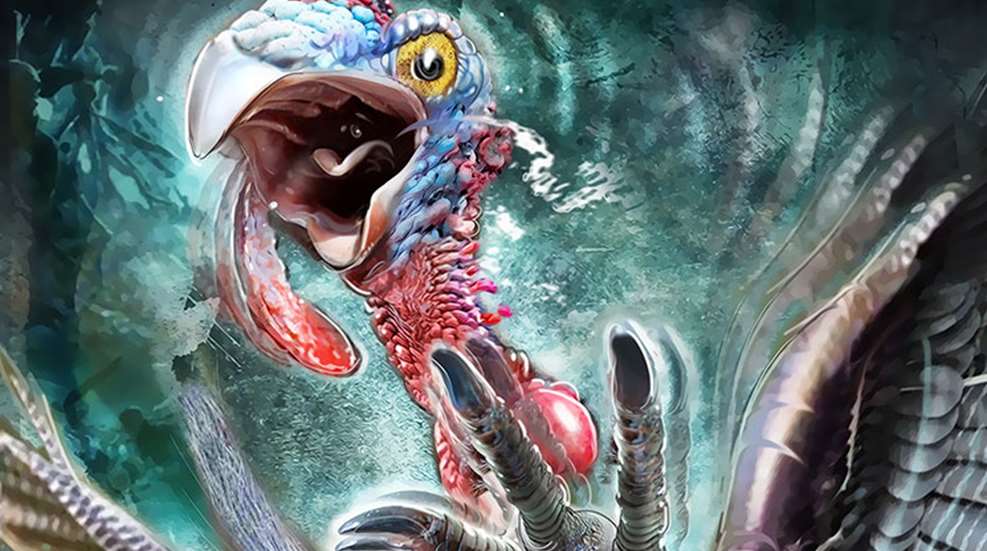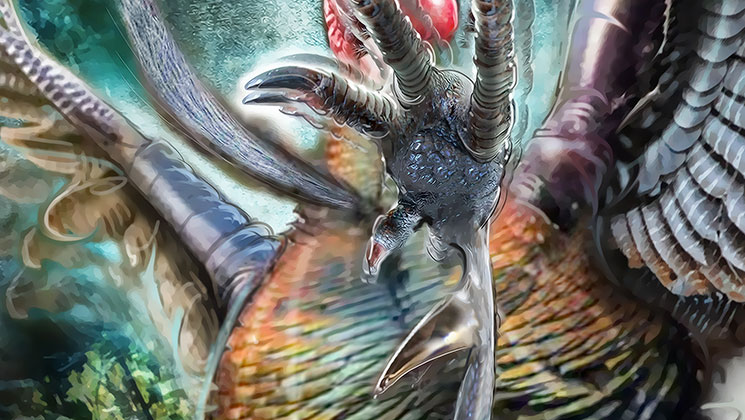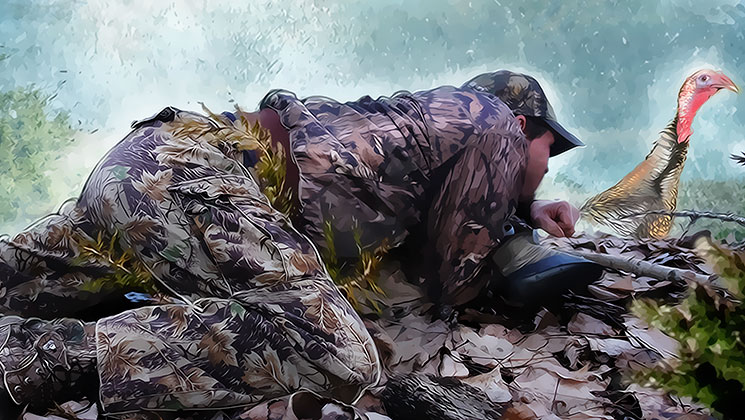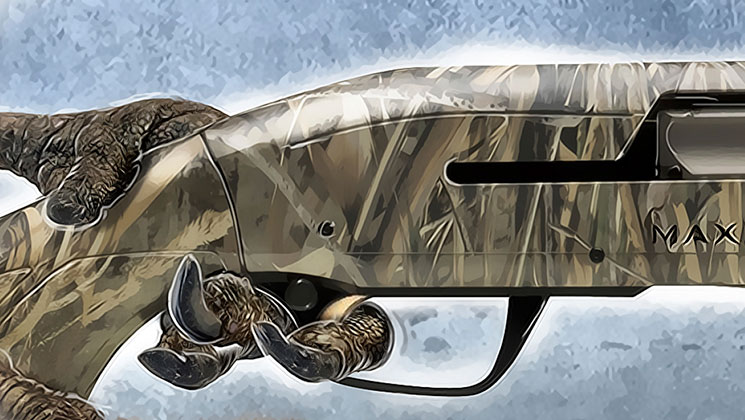
I don’t recall reading a chapter on wild turkeys in Peter Capstick’s seminal book Death in the Long Grass, wherein the professional hunter-turned-author wrote in fang-dripping detail of the inherent dangers of hunting lion, leopard, Cape buffalo and other beasties that habitually harm folks. But that doesn’t mean gobblers can’t be dangerous.
When I was just a whelp I heard a grisly tale about a young hunter who learned this the hard way. I’m not sure if the story is true, but I know it has haunted me all these years, and it influenced my actions on a recent turkey hunt in Nebraska, of which I will relay momentarily. But first, the tale goes like this …

A giant Missouri gobbler with jailhouse shanks for spurs circled behind 14-year-old Roger and his grandfather, who sat just behind the boy with his back against an oak. For anyone who doesn’t know, the corn-fed Eastern gobblers of breadbasket states like northwest Missouri, Iowa and Illinois can weigh more than 30 pounds and grow spurs wicked enough to make a meat hook question itself. This particular old boss had crept within 20 yards of the young hunter when gramps unleashed what would’ve been a yelp on his box call had it not been cut off by a gobble that all but ripped the boy’s heart out of his chest and slammed it on the hickory stump beside him. He damn near wet his cotton-duck britches. Both grandpa and grandson froze—as much as one can freeze when adrenaline surges through the veins like diesel through an I-35 truck stop—and they waited. Senses magnified, Roger heard the turkey’s toes mash oak leaves like a 4-year-old chomping Cap’n Crunch then the strange and scary drumming sound that reverberated directly off the sides of his soul.
Soon Roger’s straining eyes detected movement. He blinked once, and there it was, like a deep-woods haunt. Its head was fiery at first before changing to hues of Old Glory, what with whites and blues set to explode like an overheated lava lamp. The bird probed its woods intently with angry eyes. If it were any closer, Roger could have taken it with a T-ball bat rather than the 20-gauge side-by-side that quivered on his knee. At three paces, the bird swiveled away from Roger in search of the faux hen that piqued his libido.
Even at his young age, Roger was a keen hunter and his instincts were right on—most of them, anyway. In one movement, he pressed his face against the Ithaca’s walnut, swung the 30-inch barrels until the brassy bead was pinned to the base of the turkey’s bald pate and mashed the trigger. The blast took the giant gobbler’s head off. There was nothing clean about it.
A moment later, as the woods still quaked from the mighty roar, young Roger jumped to his feet and whooped with glee. The king of the woods lay lifeless four short steps away. Grandpa, meanwhile, struggled to regain his feet that were numb from poor circulation. Twenty seconds had passed before he gathered his calls, stood up and turned around to congratulate his grandson. Grandpa was expecting to see a flopping bird—you know, reflexive seizures due to the severing of the bird’s spinal cord—but instead saw that Roger had already loaded the gobbler into the game pouch of his hunting vest headfirst and was beaming with pride.
“Watch it son,” said Grandpa calmly. “Dead bird’s gonna flop.” But Roger either didn’t hear him or paid no attention in his excitement. The next moment the huge gobbler began its violent convulsions. The second or third kicking motion drove a 1 3/8-inch ebony spur into young Roger’s spine, just under the base of the skull, either paralyzing him or frightening him so badly that he fell over backward. Doctors later said the fall to the ground on top of the bird that subsequently drove the spur in farther is what killed the boy. It’s rumored that his grandpa never recovered from the experience and died a short time later.
That story has remained, er, in the back of my mind ever since I first heard it. I’m always careful to allow a head-shot turkey its final farewell by letting it shiver and flop uninterrupted until it exorcises every last bit of its birdly spirit. Besides, you can’t stop the flop, as any seasoned hunter knows. But you can honor it.
In fact, world champion turkey caller, TV show host and veteran turkey hunter Matt Morrett started a social media hashtag called #floppage a few years back. If you aren’t sure what a hashtag is, you’re probably better off, but the point is “floppage” is to be sought and celebrated. It means you were fortunate and good enough to have taken a wary wild turkey, and are about to sack it up and proudly drive home. So it was ironic that I found myself hunting with none other than Matt Morrett—who now works for Zink Calls—in north-central Nebraska last year. I had two turkey tags, and the private land leased by our outfitter, The Roost, was flush with birds.
When we pulled into a feedlot bordering an undulating corn field, we instantly observed a bustling flock of Merriam’s turkeys near a weedy edge several hundred yards distant. Just to the right of the bunch was a barbed-wire fence and a thick row of cedar trees that were planted long ago as a windbreak. Such cedar lines are very common in this part of Nebraska, and hunters, cows and farmers are very fortunate to have them. Turkeys … not so much.
The flock was not spooked by the truck because the birds were obviously conditioned to the rancher feeding stock. After my suggestion of a drive-by was nixed by our guide, Jeremy, we slowly backed out and drove to a low place in the hilly farm country where we could circle around the turkeys by way of the cedars and likely ease within calling distance. Morrett would do the rest—or so I thought.

When we reached the cedars, I slithered through them and, to my delight, was instantly greeted by the first hen in the flock as she single-filed her way down the fence line. I noticed her ear hairs needed trimming. Suddenly, another hen popped over the horizon, followed by another then another. Brother, we were in business! We knew there were several gobblers in the flock, and now we had the most realistic decoys ever invented jaywalking in front of us. (Sorry Avian-X, but you’re a close second.)
The best calling advice I’ve ever received is, whether it’s a turkey, duck, coyote or whatever, if the animal is coming toward you—doing what you want it to do—shut up! You can only mess it up if you call. So that’s exactly what the world champion caller did. Nothing.
A moment later the boss gobbler appeared, full strut, while herding his harem. I promptly broke him down like a sack of lightbulbs with a load of Browning No. 6’s. Less than 10 minutes into our hunt, we had a big bird down. I placed my Browning Maxus on the ground and snapped a few pictures of him while waiting out the flop. When it subsided I picked him up and lugged him to a more scenic place for photos. Sometimes (very rarely, actually) that’s how a turkey hunt goes. And when it does I’ll gladly take it, but not without thanking the turkey gods.
Now I’m not sure about you, dear reader, but I’m the type who’s often suspicious of overly good luck. It seems any time I get cocky or start thinking I’m the man, bad luck or even disaster strikes me as if to remind me of my own mortality. If I ever stumble upon a pot of gold, for example, I’ll watch out for lightning after the rainbow vanishes, believing the heavens will out balance themselves by blacking my ego and my hairline with a hearty strike from above. Maybe I’m just paranoid. Whatever. I had another tag, and I knew Morrett was eager to show me his prowess with Zink’s new mouth call that was named after his likeness. So we set off for another turk. And here’s where it gets weird.
It was windy that day. I mean really windy—the kind of wind that washes over the Nebraska flats and takes a farmer’s hat and his four-letter words with it. We were lucky to hear the faint gobble at all, but we did, so Jeremy, Morrett and I crawled around yet another row of cedars for a snoop. Sure enough, we eyeballed another flock and a couple of longbeards working the CRP field not far ahead. So Morrett began his mouth-call magic.
And that’s when nothing happened. So Morrett called more. Not only did no gobbler dash to his calls, but the birds actually went the other way. Soon they vanished altogether like Andy Dufresne in “The Shawshank Redemption.” There was a lowland bowl surrounded by woods the birds had likely used to pull the Houdini act, but from there they could’ve gone anywhere. We duck-walked along the tree line with eyes up and ears windward.
A few minutes later we heard a gobble, but this time it emanated from the opposite side of the cedars, in the cornfield from whence we had come. The bird couldn’t have been far from the truck. In fact, I thought it might be in the truck and about to drive away! I slithered through the tangle of cedar bows that perforated my knees and elbows like a demented acupuncture doctor. I’d like to think Carlos Hathcock would’ve given me high marks. Even before I reached the edge, I spied two conspiring toms in the field, on the far edge of a shotgun’s usefulness. One of them had a beard like Willie Robertson that dangled down to his scaly ankles. I inch-wormed up, poked the Browning’s pipe through the branches and pasted the bead on the top of the hairy bird’s beak. He didn’t appear particularly sinister as he pirouetted, but then again, neither does Nancy Pelosi.
With no cover to move forward, and Matt’s calls beginning to grate on me, I realized it was now or never. I squeezed the trigger and felt the recoil from the 3½ -inch magnum. Yes, a 3½ -inch magnum. I love this shell and this is why: The big Nebraska gobbler that had been standing far out in the field dropped as if he’d been hammered by John Henry himself.
I was on the bird like a pouncing cat, even before Morrett had fully untangled himself from the cedars. Although I felt like celebrating—in my book any big gobbler is a trophy regardless of whether it’s bushwacked or called—I remembered the story of Roger. I held off jacking with the bird until the flops had come and gone.
Meantime, as a student of shotguns, shells, chokes, turkeys and turkey hunting, I desired to learn the distance at which I’d shot this gobbler. So I placed the shotgun on safe and set it down 5 yards from the folded bird. As I peered through my Halo rangefinder and tried to identify the exact cedar tree from which I’d fired, the gobbler, predictably, started flopping. I paid little attention.
About this time, Jeremy rounded the cedars and unleashed a victory whoop as he saw the flopping turkey near my feet. After all, there we were, a mere hour into our four-day hunt, and the guide’s job was complete with two longbeards in the dirt. It’d be high-fives, photos and then naps all around! Meanwhile, the gobbler kept flopping like a bird possessed.
I finally determined the exact limb from where I’d fired. Fifty-eight yards—that’s longer than I’d thought, I reflected, just as my attention snapped back to the bird.
He flopped twice more and was almost to my shotgun that, because I had no other place to put it, was lying in the loose dirt of the unplanted corn field, ejection port up. I took a step toward the gun to retrieve it, but before I could, the last writhing flop placed the feathery beast’s 19-pound bulk directly on the 12-gauge. I saw the turkey’s toes savagely grasp air and curl as they came down squarely on the trigger guard. His middle toe landed on the trigger and then jerked back violently. Watching this in slow motion like a bad dream, I screamed and hopped into the air as if playing double Dutch, just as the shotgun went off. Its deadly swarm of lead scraped a new furrow in the soil under my feet that would surely save the farmer some time. The empty shell landed a moment after I did. Then all was still.
“What just happened?” yelled Jeremy as he approached, albeit with newfound caution. The turkey lay motionless inches from the gun, as I stood with mouth agape. “Did what I think just happened, happen?!” he croaked.
“Yep,” I said, now with a brand new batch of the shakes. Had I been a smoker, I would’ve lit a Camel despite the warnings that Camels cause death in humans. “It would’ve blown my feet off, and I might’ve bled out right here,” I deadpanned. “Dang turkey nearly killed me!”

Postscript
While some of the details of this story may be exaggerated, the shotgun going off due to the turkey flopping on it was very real. I am sure I put the gun’s cross-bolt safety on “safe” before setting it down. The turkey flopped on it once, and in one motion punched off the safety and coincidently pulled the trigger with its hooked, convulsing toe. (Thank God Jeremy witnessed the whole thing, or else he would have just figured I’d had an accidental discharge, and that would set back the reputations of all outdoor writers for the next 100 years.)
Sometimes accidents do happen, but if there is a lesson here, it’s that I should have cleared my shotgun before setting it down. I had just filled my last turkey tag; my hunt was over. Although I regularly hunt with a loaded gun and carry a loaded gun daily for protection, in this case I should have unloaded my shotgun immediately when the hunt concluded. I am thankful it was a cheap reminder of an important lesson.




































